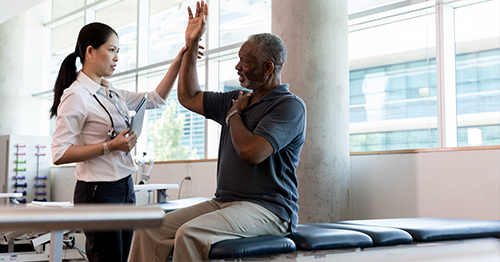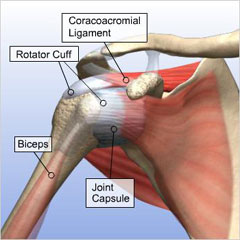Rotator Cuff Tears, Injuries and Treatments

Rotator cuff conditions are very common, affecting two to four million or people in the United States every year. Most people who have a rotator cuff injury can recover with rest and physical therapy. However, more serious injuries, such as complete rotator cuff tears, may require surgical repair.
What is a rotator cuff?
The rotator cuff of the shoulder is made up of four muscles. Tendons of these muscles come together to form a covering around the head of the upper arm bone (humerus) and top of the shoulder. The rotator cuff muscles are important stabilizers and movers of the shoulder joint. As the name implies, the rotator cuff functions to allow you to rotate your shoulder and lift your arm.

Diagram of the shoulder, including the location of the rotator cuff
What are common rotator cuff injuries?
Common rotator cuff injuries include rotator cuff tendonitis and rotator cuff strain, which is a partial or complete tear of the rotator cuff.
Rotator cuff tendonitis is inflammation or irritation in the tendons and cuff muscles that help move your shoulder joint. This injury typically occurs over time, usually as a result of keeping your shoulder in a single position for a prolonged period (such as sleeping on your shoulder every night), by overhead work-related activities, or athletic activities such as tennis, baseball, cricket or jai alai.
A rotator cuff tear may be partial or complete. A partial tear is when one of the tendons of the rotator cuff is frayed or damaged. A complete tear (also called a full-thickness tear) is when the tendon in is severed in half or pulled completely off of the bone.
Rotator cuff tears often occur over time from prolonged wear and tear. However, the rotator cuff may also be acutely injured by trauma involving a fall on the arm and shoulder or from heavy lifting. (It is common among weightlifters.) A dislocated shoulder injury may also cause a torn rotator cuff.
What are the symptoms of rotator cuff tendonitis?
Rotator cuff tendonitis is the inflammation or irritation of the tendons and muscles in the shoulder joint. Symptoms of rotator cuff tendonitis typically get worse over time. These symptoms may include:
- pain or swelling in the front of the shoulder
- pain or swelling in the side of the arm
- pain when raising or lowering the arm
- clicking or popping sound when the arm is moved
- pain that disrupts sleep
- loss of mobility or strength in affected arm
What are the symptoms of a torn rotator cuff?
Symptoms of a partial or complete torn rotator cuff may include:
- pain in the front and/or down the outside of the shoulder
- having trouble raising the arm
- experiencing weakness in the shoulder
- feeling pain when the arm is moved in certain ways
- being unable to lift things
- hearing clicking or popping when the arm is moved
How are rotator cuff injuries diagnosed?
A doctor will first take the patient’s medical history and perform a physical examination to:
- locate areas of shoulder pain or tenderness
- test the range of motion and, possibly, the strength of the shoulder joint
If a tear is suspected, an X-ray and/or MRI may be ordered.
When diagnosing a shoulder cuff injury, a doctor will also rule out conditions that can cause similar symptoms, such as a compressed nerve in the neck (called a "pinched nerve") or shoulder arthritis.
How is rotator cuff tendonitis treated?
The treatment for rotator cuff tendonitis includes first reducing swelling and inflammation then strengthening muscles and improving range of motion. Treatments may include:
- rest
- NSAIDs (nonsteroidal anti-inflammatory drugs)
- corticosteroid injections
- platelet-rich plasma (PRP) injections
All of the above treatments are usually followed by supervised physical therapy to regain shoulder motion and strength.
How is a rotator cuff tear treated?
Mild rotator cuff tears may be treated nonsurgically with anti-inflammatory medication, steroid injections and/or physical therapy. However, for more severe tears or for active individuals who engage in sports or overhead work, surgery is often recommended.
A partial or complete tear of the rotator cuff tendon is generally repaired by arthroscopic surgery. Open surgery (using a larger incision) may be necessary for large, complicated full tears of the rotator cuff.
When, years after a rotator cuff tear, a person develops severe shoulder arthritis, they my benefit from a surgery called reverse shoulder replacement.
How long does it take to recover from a rotator cuff injury?
The minimum recovery time for rotator cuff tendonitis is generally two to four weeks. Left untreated, rotator cuff tendonitis can worsen and may lead to a partial or complete rotator cuff tear.
Symptoms of a partial or complete rotator cuff tear can last from several weeks up to several months depending on the severity of the injury and the treatment plan.
When should I see a doctor for a rotator cuff tear?
You should see an orthopedic surgeon or sports medicine doctor if pain from a rotator cuff injury is affecting your daily life, waking you up from sleep or reducing your range of motion. Make an appointment to see a doctor if:
- Your shoulder hurts when you do the same activity over and over.
- You experience a loss in range of motion.
- Shoulder pain awakens you from sleep.
- Shoulder pain is accompanied by swelling, redness, or tenderness around the joint.
Further reading on rotator cuff injuries
Get more detailed information on rotator cuff injuries and treatments from the articles and other content below, or find a sports medicine doctor or surgeon at HSS suits your particular condition and insurance.
Articles on rotator cuff injury prevention
Articles related to treatments for rotator cuff injuries
Find articles and videos on surgical and nonsurgical treatments for rotator cuff injuries.
Articles rotator cuff injury for healthcare professionals
The below articles are intended for primary care physicians and other medical professionals, but may also be of interest to patients.
Rotator Cuff Tears, Injuries and Treatments Success Stories
In the news
References
- YaDeau JT, Soffin EM, Tseng A, Zhong H, Dines DM, Dines JS, Gordon MA, Lee BH, Kumar K, Kahn RL, Kirksey MA, Schweitzer AA, Gulotta LV. A Comprehensive Enhanced Recovery Pathway for Rotator Cuff Surgery Reduces Pain, Opioid Use, and Side Effects. Clin Orthop Relat Res. 2021;479(8):1740-1751. doi:10.1097/CORR.0000000000001684
- Fu MC, O'Donnell EA, Taylor SA, Aladesuru OM, Rauck RC, Dines JS, Dines DM, Warren RF, Gulotta LV. Delay to Arthroscopic Rotator Cuff Repair Is Associated With Increased Risk of Revision Rotator Cuff Surgery. Orthopedics. 2020;43(6):340-344. doi:10.3928/01477447-20200923-02
- Oh LS, Wolf BR, Hall MP, Levy BA, Marx RG. Indications for rotator cuff repair: a systematic review. Clin Orthop Relat Res. 2007;455:52-63. doi:10.1097/BLO.0b013e31802fc175.
Updated: 12/16/2019